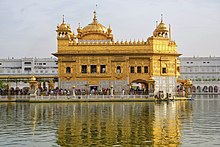Златен храм
Златниот Храм (исто така познат како Хармандир сахиб (лт. „Божја куќа“, или Дарбар сахиб, или Суваран Мандир) е гурдвара лоцирана во градот Амритсар, Пенџаб, Индија. Се смета за најсветите места во сикизмот, заедно со Гурдвара Дарбар Сахиб Картарпур во Картарпур и Гурдвара Џанам Астан во Нанкана Сахиб.
| Златен Храм | |
|---|---|
 | |
| Основни податоци | |
| Мреж. место | sgpc.net/sri-harmandir-sahib/ |
Вештачкиот базен на местото на храмот бил завршен од четвртиот Сик Гуру, Гуру Рам Дас, во 1577 година.[1][2] Во 1604 година, Гуру Арјан, петтиот Сик Гуру, ставил копија од Ади Грант во Златниот храм и билa истакната фигурата во неговиот развој.[3][4] Гурдварата била постојано обновувана од Сиките, откако станала цел на прогонот и била уништена неколку пати од страна на Могулското царство и освојувачите на авганистанските војски.[3][5][6] Махараџа Ранџит Синг, по основањето на империјата на Сиките, го обновил во мермер и бакар во 1809 година, а светилиштето го обложил со златни листови во 1830 година. Ова придонело за да го добие името Златен храм.[7][8][9]
Наводи
уреди- ↑ Louis E. Fenech & W. H. McLeod 2014.
- ↑ Pardeep Singh Arshi 1989.
- ↑ 3,0 3,1 Празен навод (help)
- ↑ W. Owen Cole 2004
- ↑ Празен навод (help)
- ↑ M. L. Runion (2017). The History of Afghanistan, 2nd Edition. Greenwood. стр. 69–71. ISBN 978-0-313-33798-7. Архивирано од изворникот на 8 March 2024. Посетено на 2 May 2018., Quote: "Ahmad Durrani was forced to return to India and [he] declared a jihad, known as an Islamic holy war, against the Marathas. A multitude of tribes heralded the call of the holy war, which included the various Pashtun tribes, the Balochs, the Tajiks, and also the Muslim population residing in India. Led by Ahmad Durrani, the tribes joined the religious quest and returned to India (...) The domination and control of the [Afghan] empire began to loosen in 1762 when Ahmad Shah Durrani crossed Afghanistan to subdue the Sikhs, followers of an indigenous monotheistic religion of India found in the 16th century by Guru Nanak. (...) Ahmad Shah greatly desired to subdue the Sikhs, and his army attacked and gained control of the Sikh's holy city of Amritsar, where he brutally massacred thousands of Sikh followers. Not only did he viciously demolish the sacred temples and buildings, but he ordered these holy places to be covered with cow's blood as an insult and desecration of their religion (...)"
- ↑ Trudy Ring, Noelle Watson & Paul Schellinger 2012.
- ↑ Eleanor Nesbitt 2016.
- ↑ Jean Marie Lafont (2002). Maharaja Ranjit Singh: Lord of the Five Rivers. Oxford University Press. стр. 95–96. ISBN 978-0-19-566111-8.